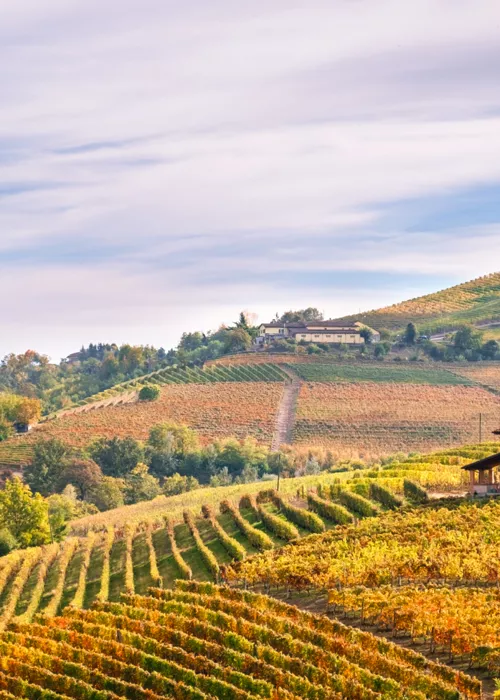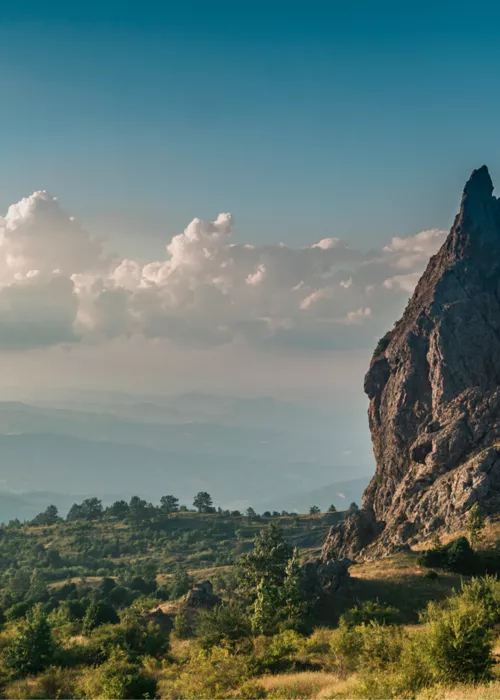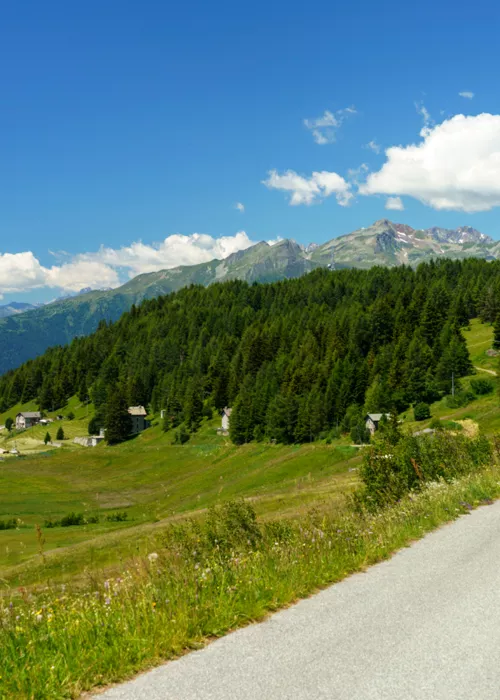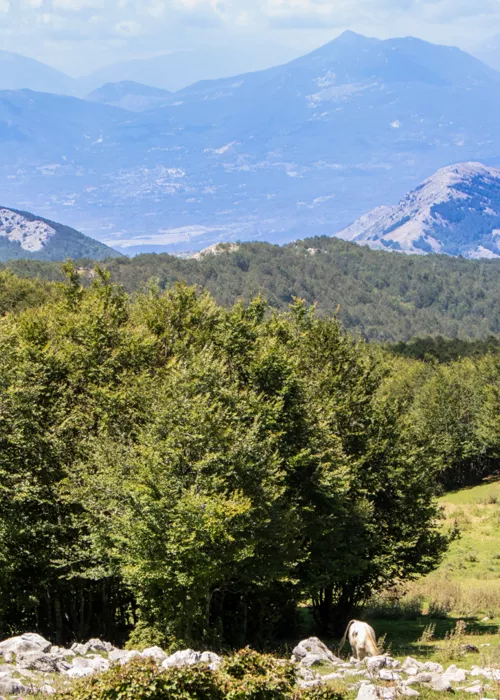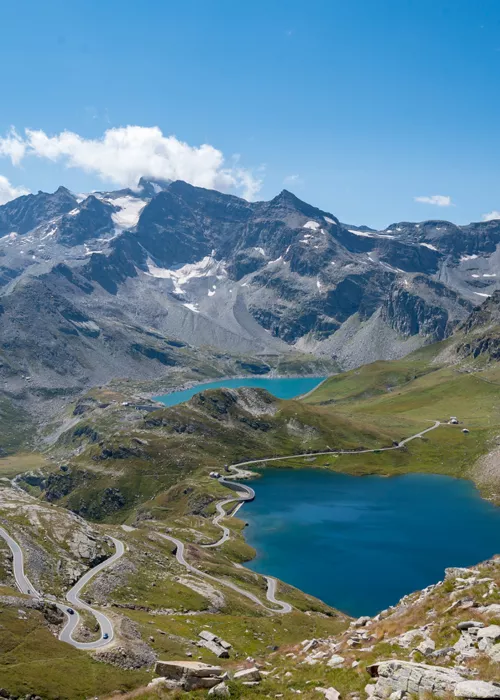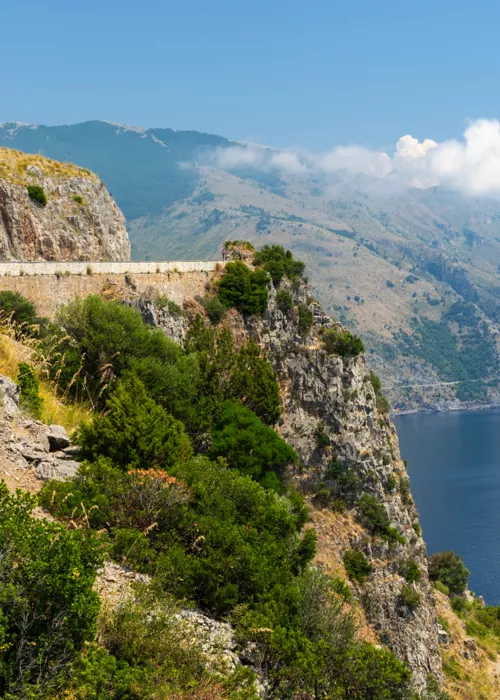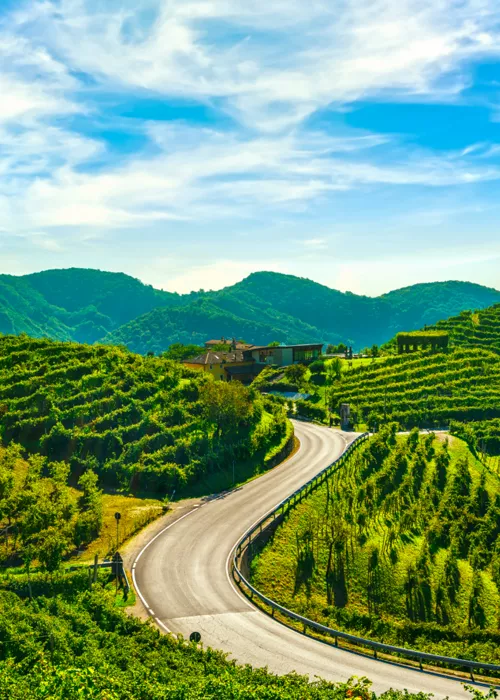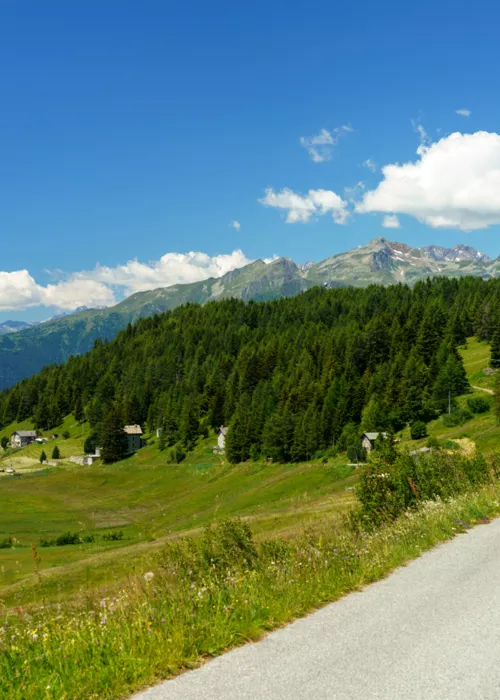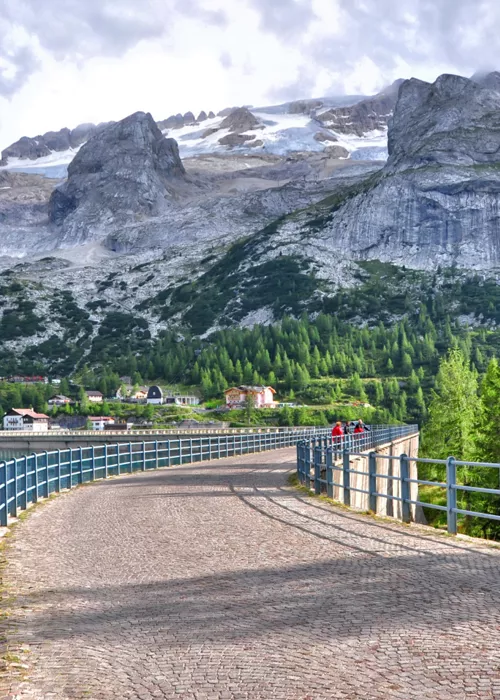Pontecagnano Faiano

From the centre of Salerno, the route runs parallel to the beautiful promenade. After crossing the bridge over the Irno River, we come to a small promontory on which stands the Fortezza della Carnale, an ancient military bulwark guarding the Strada delle Calabrie (Calabrian Road). As the old road reaches the village of San Leonardo, it skirts the austere façades of quaint 19th-century taverns and well-preserved aristocratic palaces.
The bridge over the Picentino river is the entry point into the town of Pontecagnano Faiano. The 'Ponte di Cagnano', as marked on ancient maps, as well as giving its name to the city, it has been of fundamental importance in recent centuries in the connections along the route to Calabrie. There are no traces left of the old bridge, having been replaced by a modern concrete structure.
Pontecagnano stands on the territory of the oldest Picentia, of Etruscan origin. The remains of part of the ancient Roman city have been brought to light in the area between Pontecagnano and the hamlet of Sant'Antonio, where it is now possible to visit a museum and an archaeological park.
Along the stretch leading to Eboli, there is an increase in the presence of large buildings, the sites of the ancient taverns that provided refreshment to travellers. Some of these, such as Taverna Penta, are now home to a dairy for buffalo mozzarella production.
Montecorvino Pugliano

Heading towards the Sele Plain, the Strada Regia delle Calabrie runs past the area just below the village of Montecorvino Pugliano, at the site where the Picenza posthouse stood until the 19th century.
About two kilometres from the hamlet of Sant'Antonio a Picenza, you can still see the large building that once housed the Taverna del Pagliarone, which even today, many centuries later, serves as a pit stop and refreshment point for travellers along the busy highway. The building still retains a stone portal with decorations typical of historic buildings in the Salerno area.
Leaving the Taverna del Pagliarone, a short distance away you encounter the Commonwealth War Cemetery, an emotionally impactful place, where the graves of 1846 British, Canadian, Indian, South African and New Zealand soldiers who lost their lives during the Second World War are neatly arranged, following Operation Avalanche, which took place in September 1943 by the allied troops who landed on the coast between Salerno and Paestum. A slice of recent history that deserves to be remembered and recounted.
Bellizzi

On its way to Eboli, the road briefly passes through Bellizzi, the 'youngest' of all the municipalities in the province of Salerno. It was actually founded in 1988.
We are in the 'Piana del Sele', an area with a strong agricultural tradition, known for its superb local specialities (especially the excellent buffalo mozzarella) and for its plentiful fruit and vegetable production, which is among the largest in Italy.
Recently awarded for Excellence in Governance by the European Council, Bellizzi is an interesting example of virtuous administration in southern Italy. A small, hard-working village where it is possible to visit one of the many buffalo farms, with educational tours for families and children, where all stages of mozzarella production are illustrated.
But Bellizzi is also culture and entertainment. Every year, between the end of August and the beginning of September, the Premio Fabula is held, a creative writing competition aimed at young people, with meetings and debates attended by celebrities from the worlds of film, culture and entertainment.
Battipaglia

Battipaglia is one of the main centres of the Sele plain, a presidium of excellence for the production of the mozzarella di bufala campana PDO. Here you will find many well-stocked dairies, where you can sample not only the exquisite mozzarella, but also a range of other products made from buffalo milk, including yoghurt, cheese and ice-cream.
The modern farms you can see dotted over the vast expanse of countryside, which stretches as far as the coast, are interspersed with the traditional masseria farmhouses, which are imposing buildings full of historical interest. The first one you come across is the Masseria Belvedere, near the church of Santa Maria delle Grazie, an austere and imposing building of 16th-century origin, a splendid testimony to the centuries-old farming tradition of the area. Other similar structures in the area are the Masseria de la Morella, which now houses a modern agritourism complex, and the Masseria Farina di Fiorignano, which, although in a state of disrepair, is another interesting testimony to the history and rural vocation of the Sele plain. In these buildings, a real community life based on agriculture and animal husbandry took place.
The Bridge over the Tusciano river marks the entrance to the lively centre of Battipaglia, which runs along the ancient Strada delle Calabrie, which now, having abandoned the SS18 (Tirrena Inferiore), continues along the current SS19 (delle Calabrie) to Cosenza.
Eboli

In the stretch from Battipaglia to Eboli, the old Strada Regia runs alongside the modern motorway, the Autostrada del Mediterraneo, traversing a large industrial zone where the only non-industrial building is Villa Conforti, a fine example of a late 18th-century fortified country estate that once belonged to one of Salerno's historic families.
Eboli is a city of ancient origins and has many interesting historical and architectural features. Site of a post station as early as Roman times along the Via Popilia, it has always been an important commercial and agricultural crossroads. Made famous by Carlo Levi's novel "Christ Stopped at Eboli", the town was until the first half of the 20th century the arrival point of the railway line coming from the north.
The historic core is perched between the Longobard Castle and the Church of San Francesco where, in the premises of the former Convent, there is an interesting Archaeological Museum with evidence dating back to the Neolithic period. Not far away are the Basilica di San Pietro alli Marmi, a beautiful convent complex from the Norman era, and the Museum of Operation Avalanche, which recounts the landing of allied troops on the Salerno coast during World War II.
In the picturesque alleys of the old town centre, you can stop at one of the small trattorias where you can enjoy theexcellent cuisine of the local tradition.
Campagna

Leaving the centre of Eboli, the route reaches the junction with the "Via del Grano", the ancient road that led to Melfi. Here stands theEpitaph of Ferdinand IV of Bourbon, ordered by the sovereign in 1797 to mark the inauguration of this important artery, built to facilitate the transport of grain to Naples. Walking through it, one can reach the picturesque old town of Campagna, which lies nestled in the mountains, along the course of the Tenza river. Here you will find many sights to see and a plethora of historic buildings set in stunning scenery.
Returning to the old road, follow the route downhill as far as the bridge over the Sele river, which marks the border with the municipality of Serre. The bridge is one of the most important on the Strada Regia delle Calabrie and has a very interesting history! Built in 1625, during the time of Philip IV of Spain, it consists of five arches, the last of which was designed in 1760 by the famous architect Luigi Vanvitelli and rebuilt by the Americans after it collapsed during the bombing of World War II.
Not far away is the WWF Oasis of Persano, a vast protected natural area, best known for the presence of the otter, a rare endangered mammal in Italy.
Serre

Past the Sele river is the road that leads to the military compound that houses the Reggia di Persano, an elegant hunting lodge commissioned by Charles of Bourbon in 1753 and designed by Luigi Vanvitelli. Inside, there is a beautiful staircase that ends with a marble statue of a dog, attributed to Antonio Canova.
The historic route continues, this time along a sloping unsurfaced road that coincides exactly with the old road from the Bourbon era. Traces of the pavement, the original parapets and the stone retaining barbicans are visible. At the top of this stretch is theEpitaph of Ferdinand IV of Bourbon, erected in 1779 to inaugurate the new road to Castrovillari. On the gravestone, the Latin inscription emphatically recounts the difficult stages of its construction.
We are in Serre, a small municipality at the foot of the Alburni mountains, whose historic centre, like all the villages you will encounter as far as Basilicata, is situated on a headland guarding the road, as it did until the 19th century to protect itself from enemy incursions.
Along the stretch through the territory of Serre, traces of the Via Popilia, the ancient Roman road that connected the cities of Capua and Reggio Calabria, are still visible.
Postiglione

The historical itinerary begins by entering an extraordinary natural landscape, not very different from what the 18th century traveller would have encountered. In many sections, the remains of the Roman paving of the Via Popilia (also known as the "Capua-Regium" road) can still be found, and the course of the road remains faithful to the Bourbon map until it enters the territory of the municipality of Postiglione.
Even the name of this small village at the foot of the Alburni mountains hints at its origins and its role as an outpost along the Strada Regia delle Calabrie: Postiglione has always been an excellent spot from which to view the surrounding area, as far as the sea. It is even nicknamed "the Balcony of the Alburni".
It comes as no surprise then that downhill from the village was once the site of the famed "Taverna della Duchessa", a historic inn and refreshment point for 18th-century travellers embarking on the "Grand Tour". This building also functioned as a post and horse exchange station and was clearly marked on old road maps as early as the 16th century. Today, much of the original structure is visible, the only example still intact in its form all the way to Castrovillari!
Sicignano degli Alburni

The long stretch through Sicignano degli Alburni is undoubtedly one of the best parts of the Strada Regia delle Calabrie, for the beautiful scenery but also the history of the route, as recounted by travellers from bygone days.
A long climb leads to the Lo Scorzo pass, which has long provided sustenance for the weary traveller and where even today you can still enjoy the delicious traditional dishes of the Alburni region as you listen to the stories of the proprietors, whose family have been here for generations. Tradition has it that people have been stopping to eat here since Roman times. In the stretch between the hamlets of Scorzo and Zuppino, recent archaeological studies have placed the "Nares Lucanae", the post station along the ancient Via Popilia where Cicero is said to have stopped in 58 B.C., who extolled the goodness of the sausages that were served (the "lucaniche" or "luganeghe").
Once past the Scorzo mountain pass, the 'Via delle Taverne' continues downhill to the hamlet of Zuppino, occasionally skirting a few large buildings once used as taverns. Zuppino is the largest hamlet of Sicignano degli Alburni. In its square, the building that once housed the "Taverna del Fiumicello" and an ancient fountain from which a very fresh water gushes out, already described in Roman times.
Petina

Crossing the territory of Sicignano degli Alburni, attention is still drawn to the ancient taverns at the roadside. The buildings are plain and sombre in their design, with date stones over the doorways. Taverna dell'Annunziata, Taverna dell'Olmo and Taverna di San Giuseppe are three of the waypoints marked on the maps used by 18th-century travellers and can still be seen today, cloaked in the wistful charm of bygone days.
Toward Auletta, you come to a little shrine and a small road leading to the small medieval Chapel of the Crowned Virgin, which for centuries was a resting place for travellers on their pilgrimage to Rome. A little further on is the Fontana della Regina, a small but solemn Baroque building with a plaque commemorating the episode when King Ferdinand IV of Bourbon and his wife Maria Carolina stopped to quench their thirst at the spring during a journey in 1793.
Leaving Sicignano, the route crosses a small stretch downstream of the village of Petina, a picturesque medieval centre perched on the slopes of the Alburni massif, an ideal place for a stop to enjoy nature and authentic local flavours.
Auletta

The Strada Regia continues its course in the same area where the Via Popilia of Roman times passed through. This is evidenced by the Ponte della Difesa, a structure of clear Roman origins that historians have identified as the only bridge still existing on the Capua-Regium route. The remains are located on the opposite bank of the Tanagro river, in the territory of Auletta. Of the original four or five arches, only the first two remain standing today.
Crossing the tranquil countryside at the foot of the Alburni mountains, the route reaches the bridge over the Tanagro river and the crossroads leading to the village of Auletta. Just before reaching the bridge, the road skirts an old ruin covered by vegetation: this is the ancient Taverna del Ponte, which housed the Auletta post station. This structure would often be described in the diaries of travellers of the past, in particular by the famous Irish seismologist Robert Mallet, who described the damage caused by the earthquake of 1857.
The village of Auletta still retains its medieval appearance intact. With its architecture and numerous historical attractions, it ranks among the most interesting villages along the Strada Regia. A producer of a prized olive oil, the town is best known for the 'Festival of the Tanagro White Artichoke', an authentic culinary excellence of the area.



